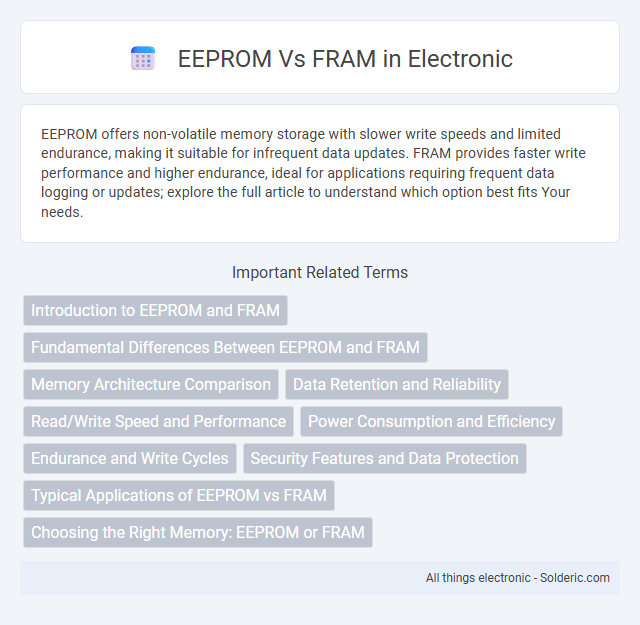EEPROM offers non-volatile memory storage with slower write speeds and limited endurance, making it suitable for infrequent data updates. FRAM provides faster write performance and higher endurance, ideal for applications requiring frequent data logging or updates; explore the full article to understand which option best fits Your needs.
Comparison Table
| Feature | EEPROM | FRAM |
|---|---|---|
| Memory Type | Non-volatile, electrically erasable programmable read-only memory | Ferroelectric RAM, non-volatile memory with ferroelectric layer |
| Write Speed | Slow (in milliseconds) | Fast (in microseconds) |
| Endurance (Write Cycles) | 10^5 to 10^6 cycles | 10^12 to 10^14 cycles |
| Data Retention | 10 to 20 years | 10+ years |
| Power Consumption | Higher during write | Lower during write |
| Application | Configuration storage, calibration data | High-speed logging, frequent writes, energy-efficient devices |
| Cost | Lower cost | Higher cost |
Introduction to EEPROM and FRAM
EEPROM (Electrically Erasable Programmable Read-Only Memory) is a non-volatile memory technology that allows data to be electrically erased and reprogrammed, commonly used for storing small amounts of data in embedded systems. FRAM (Ferroelectric RAM) offers faster write speeds, higher endurance, and lower power consumption compared to EEPROM, making it ideal for applications requiring frequent rewrite cycles. Understanding the differences between EEPROM and FRAM helps you choose the best memory solution for your device's data retention and performance needs.
Fundamental Differences Between EEPROM and FRAM
EEPROM stores data using charge trapped in floating-gate transistors, resulting in slower write speeds and limited write endurance typically around 1 million cycles. FRAM utilizes ferroelectric capacitors to store data with polarization states, enabling faster write times and exceptionally high endurance exceeding 10 trillion cycles. The fundamental difference lies in EEPROM's charge-based storage versus FRAM's polarization-based mechanism, directly impacting their performance and durability characteristics.
Memory Architecture Comparison
EEPROM utilizes a floating-gate transistor architecture allowing data storage through charge trapping, enabling non-volatile memory retention but requiring higher write voltages and slower write speeds. FRAM employs ferroelectric capacitors for data storage, leveraging polarization states for faster write speeds and lower power consumption with excellent endurance. The fundamental architectural difference results in FRAM's superior write efficiency and longevity compared to EEPROM's charge-based cell design.
Data Retention and Reliability
EEPROM offers data retention of up to 10 to 20 years with moderate endurance cycles around 1 million writes, making it reliable for long-term storage but limited by slower write speeds and wear. FRAM provides superior reliability with data retention spanning over 10 years and endurance exceeding 10^12 write cycles, enabling faster write operations and enhanced durability in frequent write environments. The enhanced endurance of FRAM ensures consistent data integrity and reduces failure risks in applications requiring extensive data logging and repeated writes.
Read/Write Speed and Performance
FRAM offers significantly faster read/write speeds compared to EEPROM, enabling quicker data access and lower latency in performance-critical applications. Unlike EEPROM, which requires longer write cycles due to its charge-trapping mechanism, FRAM uses a ferroelectric layer allowing rapid and energy-efficient data storage. Your choice between EEPROM and FRAM should consider these performance differences to optimize system responsiveness and longevity.
Power Consumption and Efficiency
FRAM (Ferroelectric RAM) significantly outperforms EEPROM (Electrically Erasable Programmable Read-Only Memory) in power consumption, utilizing less energy during write and erase cycles due to its non-destructive read process and lower voltage requirements. FRAM's efficiency enables faster write speeds and higher endurance, offering over 10^14 write cycles compared to EEPROM's typical 10^5 to 10^6 cycles, which reduces the need for power-hungry refresh operations. This makes FRAM particularly suitable for battery-operated and energy-sensitive applications where low power consumption and high write efficiency are critical.
Endurance and Write Cycles
EEPROM typically offers endurance of around 1 million write cycles per memory cell, making it suitable for moderate write frequency applications. FRAM significantly outperforms EEPROM with endurance exceeding 10^12 write cycles, enabling high-frequency data logging and frequent updates without degradation. The superior write cycle capability of FRAM also reduces latency and power consumption compared to EEPROM in repetitive write operations.
Security Features and Data Protection
EEPROM and FRAM differ significantly in security features and data protection capabilities. EEPROM offers robust write protection mechanisms, including hardware lock bits and software-controlled write cycles, making it suitable for secure data storage where overwrite prevention is critical. FRAM provides high endurance and fast write speeds but generally lacks advanced built-in security features, relying on external encryption or error-checking codes for data integrity and protection.
Typical Applications of EEPROM vs FRAM
EEPROM is widely used for storing firmware, configuration settings, and small amounts of non-volatile data in devices like microcontrollers, remote controls, and smart cards due to its high endurance and reliability. FRAM, with its faster write speeds and higher write cycle endurance, is ideal for data logging, real-time metering, and wearable devices where frequent data updates and low power consumption are crucial. Understanding the typical applications of EEPROM versus FRAM helps you choose the best memory technology for your specific project requirements.
Choosing the Right Memory: EEPROM or FRAM
Choosing the right memory between EEPROM and FRAM depends on factors such as write speed, endurance, and data retention. EEPROM offers non-volatile storage with slower write cycles and limited endurance, typically around 1 million write/erase cycles, making it suitable for infrequent writes. FRAM provides faster write speeds, significantly higher endurance--up to 10^14 write cycles--and low power consumption, ideal for applications requiring frequent and rapid data logging.
EEPROM vs FRAM Infographic

 solderic.com
solderic.com